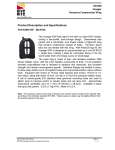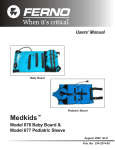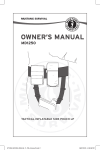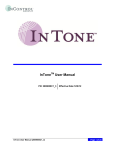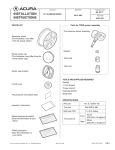Download Advice For Pregnant Women Protecting the - Techinfo
Transcript
▼ ▲ Main Menu Advice For Pregnant Women Protecting the mother is the best way to protect her unborn child. Therefore, a pregnant woman should wear a properly-positioned seat belt whenever she drives or rides in a car. If possible, use a lap/shoulder seat belt, remembering to keep the lap portion as low as possible (see page 19). Each time you have a check-up, ask your doctor if its okay for you to drive and how you should position a lap/shoulder seat belt. Seat Belt Maintenance For safety, you should check the condition of your seat belts regularly. Pull out each belt fully and look for frays, cuts, burns, and wear. Check that the latches work smoothly and the lap/shoulder belts retract easily. Any belt not in good condition or not working properly should be replaced. If a seat belt is worn during a crash, have your dealer replace the belt and check the anchors for damage. If your seat belts get dirty, you can use a soft brush to clean them with a mixture of mild soap and warm water. Do not use bleach, dye, or cleaning solvents. They can weaken the belt material. Let the belts air-dry before you use the car. Dirt build-up in the metal loops of the seat belt anchors can cause the belts to retract slowly. Wipe the inside of the loops with a clean cloth dampened in mild soap and water. SEAT BELT ANCHOR METAL LOOP ▼ ▲ Main Menu Supplemental Restraint System FRONTAL COLLISION RANGE All Accords are equipped with a Supplemental Restraint System (SRS) to help protect your head and chest during a severe frontal collision. This system does not replace seat belts. It supplements, or adds to, the protection offered by your seat belt. Not wearing a seat belt increases the chance of serious injury or death in a crash, even if you have an airbag. Be sure you and your passengers always wear seat belts and wear them properly. ▼ ▲ Main Menu SRS DRIVER'S AIRBAG SENSOR SENSOR SRS CONTROL UNIT The main components in your SRS are: An airbag in the steering wheel for the driver. A diagnostic system that when the ignition is ON (I I) continually monitors the sensors, control unit, airbag activator, and all related wiring. An indicator light to warn you of a possible problem with the system. Emergency power backup in case your car's electrical system is disconnected in a crash. Important Safety Reminder Even with an airbag, you need to wear a seat belt. The reasons are: Airbags only inflate in severe frontal collisions. They offer no protection in rear impacts, side impacts, rollovers, or moderate frontal collisions. An airbag inflates and deflates very quickly. It cannot protect you during any additional impacts that can occur during a crash. A seat belt helps keep you in the proper position when an airbag inflates. An airbag opens with considerable force, and it can hurt you if you are not in the proper position. ▼ ▲ Main Menu Supplemental Restraint System (cont'd) How the Airbag Works If you ever have a severe frontal collision, your airbag will instantly inflate to help protect your head and chest. When the airbag inflates, you may hear a fairly loud noise and you might see smoke and powder. This is normal; it is caused by the inflation of the airbag. To do its job, the airbag inflates with considerable force. So, while it can reduce serious injuries and even save your life, the airbag might cause some facial or other abrasions. After the bag completely inflates, it immediately starts deflating so it won't interfere with your visibility, ability to steer, or ability to operate other controls. ▼ ▲ Main Menu The airbag is stored in the center of the steering wheel. For safety, do not attach any items to the steering wheel. They could interfere with the proper operation of the airbag. Or, if the airbag inflates, they could be propelled inside the car and hurt someone. How the SRS Indicator Light Works SRS The purpose of the SRS light on your instrument panel is to alert you of a potential problem with your supplemental restraint system. Have the system checked if: The light does not come on when you turn the ignition ON (I I). The light stays on after the engine starts. The light comes on or flashes while you are driving. ▼ ▲ Main Menu Supplemental Restraint System (cont'd) System Service Your supplemental restraint system is virtually maintenance free. There are no parts you can safely service. You must have the system serviced by an authorized Honda dealer: If your airbag ever inflates. The bag must be replaced. Do not try to remove or discard the airbag by yourself. This must be done by a Honda dealer. If the SRS indicator light alerts you of a problem. Have the supplemental restraint system checked as soon as possible. Otherwise, your airbag might not inflate when you need it. When the car is 10 years old. Get the system inspected. The production date is on the left rear doorjamb for your convenience. System Service Precautions Do not modify your steering wheel or any other part of the supplemental restraint system. Modifications could make the system ineffective. Do not tamper with the system components or wiring. This could cause the airbag to inflate inadvertently, possibly injuring someone very seriously. Tell anyone who works on your car that you have a supplemental restraint system. Failure to follow the procedures and precautions in the official Honda service manual could result in personal injury or damage to the system. Scrapping an entire car that has an uninflated airbag can be dangerous. Get assistance from a Honda dealer if your car must be scrapped. If you sell your car, please be sure to tell the new owner that the car has a supplemental restraint system. Alert them to the information and precautions in this part of the Owner's Manual. ▼ ▲ Main Menu Additional Safety Information Your seat belt and airbag are obviously important parts of your occupant protection system. In addition, you should know that sitting upright, adjusting the head restraints to the proper positions, locking the doors, and stowing things properly can increase your safety and possibly even save your life. Seat-back Position The seat-backs should be in an upright position for you and your passengers to get the most protection from the seat belts. If you recline a seat-back, you reduce the protective capability of your seat belt. The farther a seat-back is reclined, the greater the risk that you will slide under the belt in a severe crash and be very seriously injured. For information on how to adjust the seat-back, see page 8. Head Restraint Position The head restraint can help protect you from whiplash and other injuries. For the best protection, the top of the head rest should be even with the top of your ears, or as high as possible. For instructions on how to adjust the head restraints, see page 9. ▼ ▲ Main Menu Additional Safety Information (cont'd) Door Locks It is not safe to leave your car doors unlocked. A passenger, especially a child, could open a door and accidentally fall out. Also, there is a greater chance of being thrown out of the car during a crash when the doors are not locked. Storing Cargo Safely Before you drive, make sure you first securely store or tie down any items that could be thrown around the car and hurt someone, or interfere with your ability to operate the controls. Do not put any items on top of the tonneau cover. They can block your view and they could be thrown about the car in a crash. Be sure to keep compartment doors closed when the car is moving. If a front passenger hits the door of an open glove box, for example, he could injure his knees. Driving With Pets Loose pets can be a hazard while you are driving. An unrestrained pet can interfere with your ability to drive the car. In a crash or sudden stop, loose pets or cages can be thrown around inside the car and hurt you or your passengers. It is also for their safety that pets should be properly restrained in your car. The recommended way to restrain a medium-sized or larger dog is with a special traveling harness. This harness can be secured to the rear seat with a seat belt. Travel harnesses are available at pet stores. A small dog, cat, or other small animal will be safest in a rigid-sided pet carrier. Choose a style that allows you to secure it to the car's seat by routing a seat belt through the carrier's handle. For further information, contact your veterinarian or local animal protection society.









